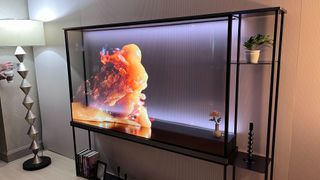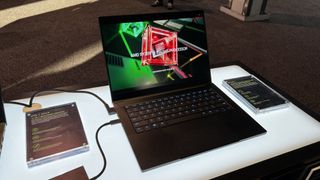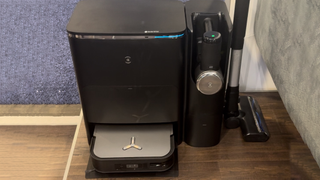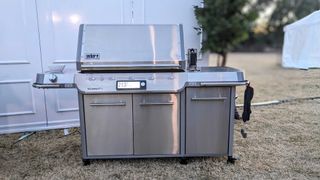We’re deep into CES 2024 now, and the TechRadar team has been prowling the halls looking for all the very best consumer tech at the show, and trying out as much of it as we can until security gets hardcore with us about the show closing for the day.
Once we’d seen as much as we could, we got everyone together to discuss the absolute best gadgets of CES 2024, ranging from new products that are being released imminently, to fantastic (but very real) prototypes that show a vision of the future that gets us excited about tech all over again.
Obviously, there being only 20 winners here means there are literally thousands of interesting and smart ideas at the show we didn’t have space to include. We saw a ton of stuff we thought was seriously great, so be sure to read all our CES news for that – but these are the products that had the extra juice that got our team talking, and stood out as our Best of CES 2024 winners.
Best TV: LG Signature OLED T
Our TV of the show simply had to be the first set to make a transparent screen into something practical that you can actually imagine owning. Do we think this will deliver the best picture quality of any TV at CES? No, but that’s not remotely the point. It pushes the art of the TV set to a new level, combining developments from LG’s ground-breaking rollable TV with its unique wireless 4K HDR 120Hz streaming tech and, of course, a clear 4K OLED panel – all built into a piece of furniture that makes it a real lifestyle object.
It can show partially transparent video, or you can watch it like a normal TV with the full contrast you expect from OLED thanks to a contrast-boosting layer that automatically rises out of the base – plus there’s powerful built-in sound, and no cable clutter thanks to the cutting-edge wireless connection box. It all adds up into something unlike anything we’ve ever seen before in the best TVs.
Best projector: Samsung The Premiere 8K
Samsung’s flagship projector for 2024, The Premiere 8K, is the world’s first to support wireless 8K streaming, something it does using an included One Connect box with Wi-Fi 7 support (picture on the right in the image above). It can beam a 150-inch 8K image when positioned just 12 inches away from a screen, and its brightness is specified at an impressive 4,000 lumens, putting it in good company among the best projectors.
The Premiere 8K is also an all-in-one solution for home theater audio and gaming. It has a built-in 8.2.2-channel Dolby Atmos sound system powered by 100 watts, and uses Sound-on-Screen tech to elevate audio from the projector up to the screen area for a more cinematic presentation. Like other Samsung projectors, it features the same smart TV interface found in the company’s TVs for streaming, along with Gaming Hub for cloud-based gaming. It’s high-end tech in a very lifestyle-friendly package and design, and we’re excited to see more of it.
Best soundbar: Samsung HW-Q990D
The HW-Q990D is the successor to Samsung’s HW-Q990C, which was already the best soundbar for anyone who wants easy but truly powerful and engrossing Dolby Atmos sound. With 22 speaker drivers and 11.1.4 channels, it’s a go-to option for complete Dolby Atmos immersion, and this year Samsung has added 4K 120Hz pass-through to its HDMI ports, fixing the only minor flaw that we found with its predecessor.
When paired with a compatible Samsung TV, the Q990C can receive Dolby Atmos signals wirelessly. It also supports Samsung’s new Active Voice Pro feature, which uses AI to dynamically highlight voices in a movie’s audio mix and elevate them for those movies where you struggle to hear what’s going on. Which will be especially welcome when the soundtrack is as powerful and hard-hitting as this soundbar is capable of being, from our time with it on the show floor.
Best speaker: Brane X
Sometimes at CES, you know the instant you try a product that you’re seeing something that changes your expectations for a type of product. The Brane X is that for the best wireless speakers. It’s a portable Wi-Fi and Bluetooth speaker that has a real, bona fide subwoofer in there. Not a bass port, not a woofer – a subwoofer that’s the equivalent of an eight-inch sub like you’d find in a soundbar’s separate subwoofer unit. You can see the air vents for it on the right side of the picture above – it covers the whole bottom of the unit.
The difference is absolutely astounding; powerful bass in music that you can feel in your diaphragm for tracks that load up on it, or just a much fuller and richer sound to acoustic instruments that covers a broader, and so more realistic, audio range – all from something the size of a six-pack. It uses a unique subwoofer design to make this happen, and combined with four other drivers, you get the best, most fulsome sound I’ve heard from any speaker that isn’t a floorstander. It’s launching imminently in the US for $599, and music fans with limited space absolutely must take notice. Not that you’d be able to avoid noticing one if it were playing in front of you.
Best headphones: Sennheiser Momentum 4 True Wireless
Sennheiser has jumped on the latest generations of Bluetooth tech with its latest wireless earbuds, adding Qualcomm’s new chip with Snapdragon Sound for CD-quality audio if you have a compatible phone, but they’re also ready for the future of regular Bluetooth with support for Bluetooth 5.4 and LE Audio and Auracast.
Most importantly, as you’d expect from Sennheiser, we’ve found they deliver superb audio quality and strong adaptive noise cancellation from what we could tell in our time with them, and still with a long battery life of 7.5 hours in the buds (though we couldn’t test that yet). Sennheiser says they’re also very low-latency, so will be a step up for gamers.
We like the design too, with a shiny finish that nods at jewelry, and a fabric case that follows Sennheiser’s other designs. It seems clear that we have a big contender for our list of the best wireless earbuds here.
Best music player: Fiio R9
This all-in-one music system for the streaming world is the ultimate hub however you like to listen, and a great-looking object to have in your home to boot. Front and center (well, actually, it’s on the left) is an Android touchscreen, with access to the full Google Play store so you can download any of the best music streaming services to listen to in maximum quality via the twin high-end 8-Channel ESS Sabre ES9038PRO DAC, via THX AAA 788+ amplification, meaning this thing can power just about anything you want to connect to it, from hard-to-support headphones to rich speakers. But in a nice touch, if you don’t want to sign up to Google, Fiio has added its own app store with major music services on board, no login required.
The box can handle basically any kind of digital file you could want to throw at it, from PCM 768kHz/32-Bit to DSD512 to MQA, and it even has two kinds of HDMI connection (ARC and straight audio, for SACD/DVD-Audio fans) and it sounds absolutely fantastic. We listened with Fiio’s new FT5 planar magnetic headphones, and there’s so much power and poise and dynamic range, all in a sleek metal design with light-up dials. For those who want the feeling of a huge music system and library in a compact space, this is irresistible.
Best laptop: Lenovo ThinkBook 13x Gen 4 SPE
Lenovo has been experimenting with E-Ink laptop covers for a few years now, and the Lenovo ThinkBook 13x Gen 4 SPE concept laptop seems like the natural evolution of its work to date. Even more though, it feels like we can finally see the point of having an E-Ink cover at all.
The E-Ink Prism technology built into the lid of the laptop enables you to create a color design on your laptop lid that isn’t just a picture, but can feature animation that brings unparalleled personalization to your device in a way a simple sticker or case on the best laptops never could.
It’s not as simple as uploading a PNG, however. The lid’s E-Ink cover is constructed from many small, but not tiny, segments that can change color to create shapes and designs on the lid with almost no power (we’re talking milliwatts here), but is still bright enough to be seen clearly from far away in a well-lit room, just the kind of thing you’d want your team to be using at a major trade conference with a company logo or other form of marketing graphic on to build hype. For the rest of us, we can still absolutely make the device our own – Lenovo’s breathed new life into laptop design with this version of the tech.
Best computing component: AMD Ryzen 8040 Series
The Ryzen 8040-series CPUs that AMD announced at CES 2024 are more than just Team Red’s answer to Intel’s Meteor Lake mobile processors, if AMD’s published benchmarks are right, it might be the AI chip to have in the best laptops next year, such as the new Razer Blade 14 pictured above, which includes the new platform.
According to AMD, the new Ryzen 8040 series processors aren’t just competitive with Intel’s newest mobile silicon, they outpace them across a wide array of workloads from gaming to the latest generative AI tools such as Stable Diffusion.
Of course, AMD is going to cherry pick its best results if it can, but if its numbers are accurate, these mobile processors can go a long way to eating into Intel’s absolutely dominant position in the mobile laptop market, and give people a real reason to switch over from Team Blue.
Best gaming tech: MSI Claw
The MSI Claw is one of the most exciting devices of CES thanks to it being the first gaming handheld to be powered by Intel Core Ultra processors with integrated Intel Arc graphics (with the exciting prospect of hardware-accelerated resolution upscaling via Intel XeSS), but the chip itself is only half the story.
MSI has a long pedigree for gaming hardware, and its new device is a stunning handheld in its own right. The 1080p display is incredibly crisp thanks to its wide color coverage and speedy refresh rate, while the 16GB LPDDR5 RAM and up to 1TB NVMe SSD storage will help make managing your game library on the go a lot less painful. We were impressed with the whole device in our MSI Claw hands-on, and we can’t wait to get deeper into using it.
Best computing accessory: Razer Project Esther
Razer Project Esther is the iconic peripherals brand’s latest take on a fairly old and often repetitive gaming technology that has always offered the promise of deeper immersion, but never really truly gotten there. While there are seams in the Project Esther’s Sensa HD Haptic technology, they are extremely tight, and the overall experience this chair cushion provides is difficult-to-describe (though I certainly tried in a hands-on preview of Project Esther earlier this week).
The long and short of what makes this cushion so different is that while many haptic products promise more immersive gaming, Project Esther comes way closer to what most people are hoping for than any competing product on the market thanks to its directional HD haptics. The closest analogue to this would be Dolby Atmos, but for haptics – and with a software development kit for game developers to fine-tune the haptic experience of their games, this device is one of the few products of this kind that gamers are really going to want if it goes on-sale.
Best mobile accessory: Clicks Keyboard
The question isn’t whether you need Clicks, the premium new keyboard that attaches to the iPhone 14 Pro and iPhone 15 Pro. The question is why aren’t there more keyboards for smartphones already? If you write a lot of messages, or even if you just write captions for your favorite photos and videos, Clicks gives you a smart new way to type that frees up a ton of screen space.
It’s pricey at $139, but it feels like a premium keyboard for your Pro-level iPhone. It’s got a backlight, and it comes in a staid London Blue or smiley-faced Bumblebee yellow that will attract glances from curious keyboard newbs and old school BlackBerry fans alike. We’ve never done more writing on our phones, and Clicks strongly makes the case that physical keys are due a comeback.
Best smart home innovation: Nanoleaf Orchestrator
Nanoleaf’s Orchestrator software is a massive improvement upon the smart lighting company’s existing Rhythm tool, taking music visualization to new heights. Not only does it interpret the beat and melodies into color palettes and motions (and allow for personalization, too), but you can even group your devices into different parts of the tracks, too.
Where Rhythm uses on-device built-in microphones to detect sound, Orchestrator picks apart music played through your laptop or PC, identifying the mood and layers of a track to create a gorgeous complimentary light show. The only software we’ve tried that comes close is Philips Hue’s, but that’s exclusive to Spotify and way less customizable.
As of writing, it’s only available on the Nanoleaf Desktop App, but we’d be very surprised if a mobile equivalent didn’t roll out within the next year or two. The fun this can add to your smart lighting setup can’t be underestimated
Best small appliance: Ecovacs Deebot X2 Combo
While the robot vacuum and mop part of this product itself isn’t brand new at CES, having released late last year, this new edition of the Deebot X2 is pretty special and novel; it features a connected handheld vacuum (or one with a handle), which also auto-empties itself into the same vacuum bag as the robot vacuum when you dock it. The space-saving potential is excellent, but more than that, the vacuum is pretty accomplished, too.
The Deebot X2 robot vacuum is square-shaped, optimized for better wall-to-wall and corner cleaning, and sporting a gorgeous, minimalist design. Plus, thanks to the Matter 1.2 rollout, the bot is now Matter-compatible, though it also supports Alexa, Google Assistant and Siri Shortcuts natively, as well as its own Yiko 2.0 voice control.
It’s just a great pairing that brings a feature that’s been a recent and extremely convenient feature of the best robot vacuums (the self-emptying tool) to the world of the best cordless vacuums. When you’ve finished, you just pop it back to charge and you don’t need to think about the dust. We love it.
Best wellness tech: Baracoda BMind
The BMind smart mirror is a glimpse into the bathrooms of the future. Powered by generative AI and Natural Language Processing, it offers personalized recommendations based on the user’s mental state, all controlled by a combination of gesture and voice commands. It can do things like detect that you look sad, and ask you how your day is going, and make changes based on your response.
For example, you can say that you’re feeling sad or down, and it will use light therapy techniques, changing its LED light output in a way that can help to improve your mood. It also has mindfulness exercises such as guided meditation built in that it can suggest and run too – all provided through the CareOS interface and programs from ThrivePal. Its built-in camera has face detection so everything is personalized for you (and kept only to you).
It can also help in more physical ways, with guided toothbrushing coaching, and skin analysis, so it can make recommendations for how to, say, reduce redness in your face. If it works as well as BMind says, it could be a much more convenient way to get help and advice than by reaching for your phone and it’ll be more personalized.
Best wearable: Evie Smart Ring
Not only is Evie a rare gem among health devices at CES, in that it will actually launch, but it’s also a wearable device that puts women first in all the best ways.
From its gorgeous, open design that accommodates the natural fluctuations in a woman’s body over the course of the month, to its intelligent application and AI insights engine, Evie’s all about putting women’s health center-stage in an industry where it’s often an afterthought.
Best of all, it’s completely subscription free, meaning you can enjoy its medical-grade sleep, blood oxygen, heart health detection and menstrual data insights without worrying about the on-going cost. This looks like a great rival to the best smart rings.
Best health tech: Withings BeamO
The idea of a do-it-all, handheld medical diagnostic devices is not new; fans of Star Trek well remember Dr. McCoy’s Tricorder. Withings’ BeamO is not quite that, but may be an exciting baby step in the right direction. It’s a lightweight, compact, all-in-one device that can run ECG, blood oxygen, temperature and even stethoscope tests.
You don’t wave BeamO in front of a body to detect trouble. Instead, you’ll place BeamO against your temple or chest (or hold the sensors on it for SPO2 and ECG readings). The exciting thing is that whatever data it collects can instantly be shared with your healthcare professional who will know how to read your health stats.
Best outdoor tech: Swarovski Ax Visio
High-end binoculars with a digital camera built-in so that you can capture what you’re looking at are nothing new. High-end binoculars with a digital camera and AI recognition software that can tell you what you’re looking at? That’s new, and extremely cool. The neural processing unit in these binoculars is similar to what you get in the latest phones, and has been trained to identify 9,000 species of birds, so you no longer need to refer to a book or call your twitching uncle to discover what was hanging out on that cliff.
Simply take a look through them like any other binoculars to find something interesting, and when you see a mystery bird, press a button on the side that will show a red circle in your vision. Get your bird into this circle, and its name will appear underneath. It’s the ideal use of this kind of technology, and a perfectly futuristic upgrade to the most old-school of products.
Best yard tech: Weber Summit Grill
Weber makes some of the most effective grills and smokers you can buy, and now the company is offering one of the most advanced with the Weber Summit Smart Grill. This is for aspiring or accomplished chefs, as the featureset could cater a serious party. Besides the six burners, the infrared element up top, and the rotisserie spit, you get a digital PID controller that truly represents the next generation of grilling. It monitors everything, from the flame activity to the temperature to the gas levels, and gives you helpful feedback where to place your food for the best direct and indirect heat cooking.
The Weber Summit grill includes remarkable safety features that check the fire constantly, and even though it looks like a fancy computer, it can handle the same extreme heat and cold weather that you’d expect from any Weber grill, so it’s not more delicate just because it’s smarter. This will turn anyone in a true grilling pro.
Best science tech: Celestron Origin
Amateur astronomers dream of powerful telescopes and long warm nights of star gazing. The reality is the best time for star gazing is in the winter, and most telescopes are exercises in frustration. Smart telescopes bridge the gap between our stargazing wishes and the ability to carry them out, and Celestron Origin takes the concept to the next level.
It does all the hard work of finding celestial bodies, and will let you schedule when you want it to find and capture imagery of the planets, stars, and galaxies. Better yet, you can do it all from the warmth and comfort of your living room couch, using an iPad or your Phone. Want to see what it captured? It’ll show up on your screen and you can cast it to your living room TV. This is the kind of armchair astronomy we can get behind.
Best car tech: BMW Augmented Reality Ride Concept
You wouldn’t think augmented reality and driving would go perfect together, and yet BMW showed me how wearing Xreal Air 2 glasses inside a beautiful EV BMW would somehow feel natural and even useful. The concept is simple: Xreal’s glasses integrate with your phone, which is connected to the car to deliver real-time AR imagery that can tell you things about your trip that you might otherwise miss or have to glance down at a screen to see. Think direction, hazards, and indications that you’re veering into the other lane, and you get the idea. The concept even extends to your passengers, who could, with their own glasses, turn any car surface into a screen for bingeing on the road.
We’re covering all of the latest CES news from the show as it happens. Stick with us for the big stories on everything from 8K TVs and foldable displays to new phones, laptops, smart home gadgets, and the latest in AI.
And don’t forget to follow us on TikTok for the latest from the CES show floor!
link






















